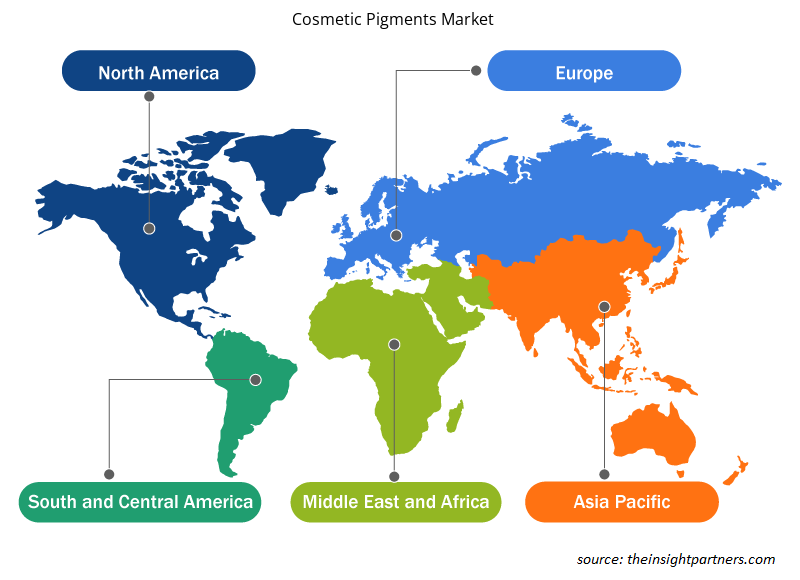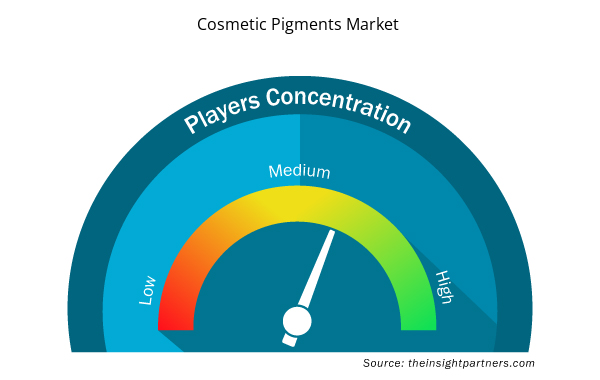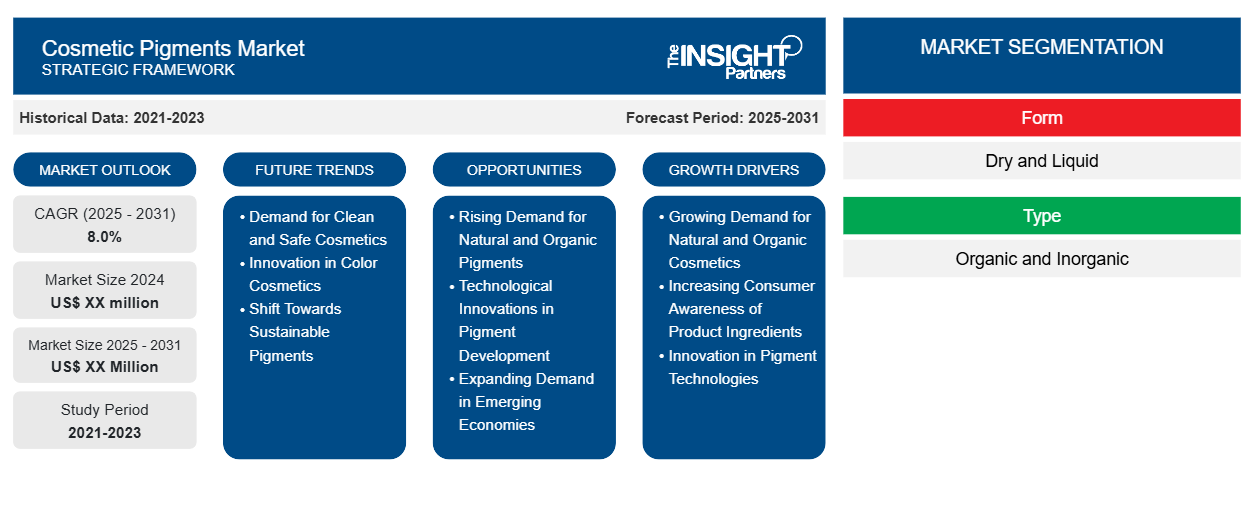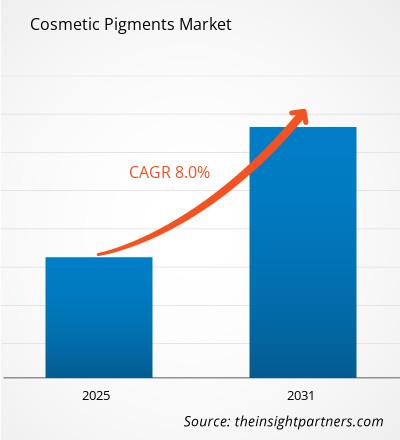化粧品顔料市場は、2024年から2031年にかけて8.0%のCAGRで成長し、市場規模は2024年のXX百万米ドルから2031年にはXX百万米ドルに拡大すると予想されています。
化粧品顔料市場は、形状、種類、用途、地域に分かれています。形状に基づいて、市場は乾燥と液体に分かれています。用途に基づいて、市場はスキンケア製品、リップケア製品、ヘアケア製品、その他に分かれています。レポートの範囲は、北米、ヨーロッパ、アジア太平洋、中東およびアフリカ、南米および中米の5つの地域と、各地域の主要国をカバーしています。グローバル分析は、地域レベルと主要国でさらに細分化されています。レポートは、上記の分析とセグメントの米ドルでの値を提供します。
報告書の目的
The Insight Partners のレポート「化粧品顔料市場」は、現在の状況と将来の成長、主な推進要因、課題、機会を説明することを目的としています。これにより、次のようなさまざまなビジネス関係者に洞察が提供されます。
- テクノロジープロバイダー/メーカー: 進化する市場の動向を理解し、潜在的な成長機会を把握することで、情報に基づいた戦略的意思決定が可能になります。
- 投資家: 市場の成長率、市場の財務予測、バリュー チェーン全体に存在する機会に関する包括的な傾向分析を実施します。
- 規制機関: 市場の濫用を最小限に抑え、投資家の信用と信頼を維持し、市場の完全性と安定性を維持することを目的として、市場における政策と警察活動を規制します。
化粧品顔料市場のセグメンテーション
形状
- 乾燥と液体
タイプ
- 有機と無機
応用
- スキンケア製品
- リップケア製品
- ヘアケア製品
- その他
地理
- 北米
- ヨーロッパ
- アジア太平洋
- 南米と中央アメリカ
- 中東およびアフリカ
要件に合わせてレポートをカスタマイズする
このレポートの一部、国レベルの分析、Excelデータパックなど、あらゆるレポートを無料でカスタマイズできます。また、スタートアップや大学向けのお得なオファーや割引もご利用いただけます。
- このレポートの主要な市場動向を入手してください。この無料サンプルには、市場動向から見積もりや予測に至るまでのデータ分析が含まれます。
化粧品顔料市場の成長要因
- 天然およびオーガニック化粧品の需要の高まり: 消費者が天然およびオーガニック化粧品に移行するにつれて、環境に優しく毒性のない化粧品顔料の需要が高まっています。植物、鉱物、その他の再生可能な資源から得られる天然顔料は、その安全性と持続可能性の高さから人気が高まっています。
- 消費者の製品成分に対する意識の高まり: 消費者は化粧品の成分に対する意識が高まっており、クリーンで安全な配合を求める声が高まっています。その結果、パラベン、フタル酸エステル、合成染料などの有害な化学物質を含まない化粧品顔料が好まれるようになりました。
- 顔料技術の革新: より持続性のある効果やさまざまな肌タイプとの適合性を高めた新しい着色剤や材料の開発など、顔料配合の進歩が市場の成長を牽引しています。化粧品メーカーはこれらの革新を取り入れ、美しさと機能性の両方に対する消費者の好みを満たす、鮮やかで安定した多用途の化粧品を提供しています。
化粧品顔料市場の将来動向
- クリーンかつ安全な化粧品の需要: クリーンかつ安全な美容製品への傾向が高まるにつれ、天然で無毒な化粧品顔料の需要が増加すると予想されます。消費者は有害な化学物質を含まない化粧品を求める傾向が強まっており、鉱物、植物、藻類などの天然資源から抽出した顔料の市場が拡大しています。
- カラー化粧品のイノベーション: 消費者がより多様でカスタマイズ可能な化粧品の選択肢を求めるにつれて、化粧品の顔料配合は、より幅広い色、質感、仕上がりを提供できるように進化しています。顔料技術の進歩により、ファンデーションからアイシャドウ、口紅まで、幅広い美容製品に長持ちする鮮やかな色を作り出すことができます。
- 持続可能な顔料への移行: 化粧品業界では持続可能性への移行が進んでおり、環境に優しく生分解性の顔料の需要が高まっています。より倫理的で環境に優しい美容製品を求める消費者の期待に応えて、再生可能な資源から抽出され、環境に優しい製造プロセスで生産された顔料が市場を席巻する可能性が高いでしょう。
化粧品顔料の市場機会
- 天然およびオーガニック顔料の需要の高まり: 消費者がクリーンでオーガニック、動物実験をしていない美容製品を好む傾向が高まっており、化粧品顔料市場には大きなチャンスが生まれています。植物、鉱物、その他の再生可能な資源から得られる天然顔料の人気が高まっており、ブランドはより安全で無毒な化粧品の需要に応えるチャンスを得ています。
- 顔料開発における技術革新: 環境への影響を最小限に抑えながら、長持ちする鮮やかな色の開発など、顔料技術の進歩により、化粧品顔料市場に新たな道が開かれると期待されています。皮膚の保護や保湿などのメリットをもたらす多機能顔料の技術革新により、美容製品の性能が向上し、新たな成長の機会が生まれます。
- 新興経済国における需要の拡大: アジア太平洋、ラテンアメリカ、中東などの新興市場で美容業界が成長を続ける中、化粧品顔料市場には大きなチャンスがあります。可処分所得の増加、都市化の進行、パーソナルグルーミング製品への欲求の高まりにより、これらの地域では化粧品顔料の幅広い選択肢に対する需要が高まります。
化粧品顔料市場の地域別分析
予測期間を通じて化粧品顔料市場に影響を与える地域的な傾向と要因は、Insight Partners のアナリストによって徹底的に説明されています。このセクションでは、北米、ヨーロッパ、アジア太平洋、中東、アフリカ、南米、中米にわたる化粧品顔料市場のセグメントと地理についても説明します。

- 化粧品顔料市場の地域別データを入手
化粧品顔料市場レポートの範囲
| レポート属性 | 詳細 |
|---|---|
| 2024年の市場規模 | XX百万米ドル |
| 2031年までの市場規模 | XX百万米ドル |
| 世界のCAGR(2025年~2031年) | 8.0% |
| 履歴データ | 2021-2023 |
| 予測期間 | 2025-2031 |
| 対象セグメント | フォーム別
|
| 対象地域と国 | 北米
|
| 市場リーダーと主要企業プロフィール |
|
化粧品顔料市場のプレーヤー密度:ビジネスダイナミクスへの影響を理解する
化粧品顔料市場は、消費者の嗜好の変化、技術の進歩、製品の利点に対する認識の高まりなどの要因により、エンドユーザーの需要が高まり、急速に成長しています。需要が高まるにつれて、企業は提供品を拡大し、消費者のニーズを満たすために革新し、新たなトレンドを活用し、市場の成長をさらに促進しています。
市場プレーヤー密度とは、特定の市場または業界内で活動している企業または会社の分布を指します。これは、特定の市場スペースに、その規模または総市場価値と比較して、どれだけの競合相手 (市場プレーヤー) が存在するかを示します。
化粧品顔料市場で事業を展開している主要企業は次のとおりです。
- サンケミカル
- センシエント・コスメティック・テクノロジーズ
- メルクパフォーマンスマテリアルズ
- スダルシャン
- Kobo製品
免責事項:上記の企業は、特定の順序でランク付けされていません。

- 化粧品顔料市場のトップキープレーヤーの概要を入手
主なセールスポイント
- 包括的なカバレッジ: レポートでは、化粧品顔料市場の製品、サービス、タイプ、エンドユーザーの分析を包括的にカバーし、全体的な展望を提供します。
- 専門家による分析: レポートは、業界の専門家とアナリストの深い理解に基づいてまとめられています。
- 最新情報: このレポートは、最新の情報とデータの傾向を網羅しているため、ビジネスの関連性を保証します。
- カスタマイズ オプション: このレポートは、特定のクライアント要件に対応し、ビジネス戦略に適切に適合するようにカスタマイズできます。
したがって、化粧品顔料市場に関する調査レポートは、業界のシナリオと成長の見通しを解読し理解する道の先導役となることができます。いくつかの正当な懸念があるかもしれませんが、このレポートの全体的な利点は欠点を上回る傾向があります。
- 過去2年間の分析、基準年、CAGRによる予測(7年間)
- PEST分析とSWOT分析
- 市場規模価値/数量 - 世界、地域、国
- 業界と競争環境
- Excel データセット



Report Coverage
Revenue forecast, Company Analysis, Industry landscape, Growth factors, and Trends

Segment Covered
This text is related
to segments covered.

Regional Scope
North America, Europe, Asia Pacific, Middle East & Africa, South & Central America

Country Scope
This text is related
to country scope.
よくある質問
Demand for clean and safe cosmetics is expected to be the key market trend.
The report can be delivered in PDF/Word format, we can also share excel data sheet based on request.
On the basis of geography, the cosmetic pigments market is classified into North America, Europe, Asia Pacific, Middle East and Africa, and South and Central America
Miyoshi Kasei Inc, Sun Chemical, LANXESS, Kobo Products, Clariant, Sensient Cosmetic Technologies, BASF SE, Geotech, Venator Materials Plc, and Neelikon Food Dyes and Chemicals Ltd are some of the players operating in the market.
The Cosmetic Pigments Market is estimated to witness a CAGR of 8.0% from 2023 to 2031
Growing demand for natural and organic cosmeticsis driving the cosmetic pigments market growth.
Trends and growth analysis reports related to Chemicals and Materials : READ MORE..
The List of Companies
- Sun Chemical
- Sensient Cosmetic Technologies
- Merck Performance Materials
- Sudarshan
- Kobo Products
- BASF SE
- Clariant
- Geotech
- Huntsman
- LANXESS
The Insight Partners performs research in 4 major stages: Data Collection & Secondary Research, Primary Research, Data Analysis and Data Triangulation & Final Review.
- Data Collection and Secondary Research:
As a market research and consulting firm operating from a decade, we have published and advised several client across the globe. First step for any study will start with an assessment of currently available data and insights from existing reports. Further, historical and current market information is collected from Investor Presentations, Annual Reports, SEC Filings, etc., and other information related to company’s performance and market positioning are gathered from Paid Databases (Factiva, Hoovers, and Reuters) and various other publications available in public domain.
Several associations trade associates, technical forums, institutes, societies and organization are accessed to gain technical as well as market related insights through their publications such as research papers, blogs and press releases related to the studies are referred to get cues about the market. Further, white papers, journals, magazines, and other news articles published in last 3 years are scrutinized and analyzed to understand the current market trends.
- Primary Research:
The primarily interview analysis comprise of data obtained from industry participants interview and answers to survey questions gathered by in-house primary team.
For primary research, interviews are conducted with industry experts/CEOs/Marketing Managers/VPs/Subject Matter Experts from both demand and supply side to get a 360-degree view of the market. The primary team conducts several interviews based on the complexity of the markets to understand the various market trends and dynamics which makes research more credible and precise.
A typical research interview fulfils the following functions:
- Provides first-hand information on the market size, market trends, growth trends, competitive landscape, and outlook
- Validates and strengthens in-house secondary research findings
- Develops the analysis team’s expertise and market understanding
Primary research involves email interactions and telephone interviews for each market, category, segment, and sub-segment across geographies. The participants who typically take part in such a process include, but are not limited to:
- Industry participants: VPs, business development managers, market intelligence managers and national sales managers
- Outside experts: Valuation experts, research analysts and key opinion leaders specializing in the electronics and semiconductor industry.
Below is the breakup of our primary respondents by company, designation, and region:

Once we receive the confirmation from primary research sources or primary respondents, we finalize the base year market estimation and forecast the data as per the macroeconomic and microeconomic factors assessed during data collection.
- Data Analysis:
Once data is validated through both secondary as well as primary respondents, we finalize the market estimations by hypothesis formulation and factor analysis at regional and country level.
- Macro-Economic Factor Analysis:
We analyse macroeconomic indicators such the gross domestic product (GDP), increase in the demand for goods and services across industries, technological advancement, regional economic growth, governmental policies, the influence of COVID-19, PEST analysis, and other aspects. This analysis aids in setting benchmarks for various nations/regions and approximating market splits. Additionally, the general trend of the aforementioned components aid in determining the market's development possibilities.
- Country Level Data:
Various factors that are especially aligned to the country are taken into account to determine the market size for a certain area and country, including the presence of vendors, such as headquarters and offices, the country's GDP, demand patterns, and industry growth. To comprehend the market dynamics for the nation, a number of growth variables, inhibitors, application areas, and current market trends are researched. The aforementioned elements aid in determining the country's overall market's growth potential.
- Company Profile:
The “Table of Contents” is formulated by listing and analyzing more than 25 - 30 companies operating in the market ecosystem across geographies. However, we profile only 10 companies as a standard practice in our syndicate reports. These 10 companies comprise leading, emerging, and regional players. Nonetheless, our analysis is not restricted to the 10 listed companies, we also analyze other companies present in the market to develop a holistic view and understand the prevailing trends. The “Company Profiles” section in the report covers key facts, business description, products & services, financial information, SWOT analysis, and key developments. The financial information presented is extracted from the annual reports and official documents of the publicly listed companies. Upon collecting the information for the sections of respective companies, we verify them via various primary sources and then compile the data in respective company profiles. The company level information helps us in deriving the base number as well as in forecasting the market size.
- Developing Base Number:
Aggregation of sales statistics (2020-2022) and macro-economic factor, and other secondary and primary research insights are utilized to arrive at base number and related market shares for 2022. The data gaps are identified in this step and relevant market data is analyzed, collected from paid primary interviews or databases. On finalizing the base year market size, forecasts are developed on the basis of macro-economic, industry and market growth factors and company level analysis.
- Data Triangulation and Final Review:
The market findings and base year market size calculations are validated from supply as well as demand side. Demand side validations are based on macro-economic factor analysis and benchmarks for respective regions and countries. In case of supply side validations, revenues of major companies are estimated (in case not available) based on industry benchmark, approximate number of employees, product portfolio, and primary interviews revenues are gathered. Further revenue from target product/service segment is assessed to avoid overshooting of market statistics. In case of heavy deviations between supply and demand side values, all thes steps are repeated to achieve synchronization.
We follow an iterative model, wherein we share our research findings with Subject Matter Experts (SME’s) and Key Opinion Leaders (KOLs) until consensus view of the market is not formulated – this model negates any drastic deviation in the opinions of experts. Only validated and universally acceptable research findings are quoted in our reports.
We have important check points that we use to validate our research findings – which we call – data triangulation, where we validate the information, we generate from secondary sources with primary interviews and then we re-validate with our internal data bases and Subject matter experts. This comprehensive model enables us to deliver high quality, reliable data in shortest possible time.


 このレポートの無料サンプルを入手する
このレポートの無料サンプルを入手する